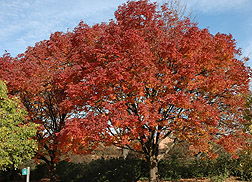This page has been archived and is being provided for reference purposes only. The page is no longer being updated, and therefore, links on the page may be invalid.
|
|
ARS Scientists Cryopreserve Pest-Imperiled Ash Trees
By Jan SuszkiwOctober 27, 2009
Using cryopreservation methods, Agricultural Research Service (ARS) scientists have devised a procedure for storing frozen budwood from ash trees (Fraxinus) and thawing the delicate buds for later use in propagation.
The advance, reported in the journal CryoLetters, should complement ongoing seed-conservation efforts aimed at preserving the genetic diversity of America's native ash species, which are susceptible to the emerald ash borer (EAB), Agrilus planipennis.
Metallic green and 1/2-inch long, this exotic beetle from northern Asia has killed tens of millions of ash trees in several states since first being detected near Detroit, Mich., in June 2002. Since then, the EAB has spread to 12 other states and two Canadian provinces.
The stored budwood samples, along with conserved seed, can serve as a national source for reintroducing ash trees once the devastation from EAB can be controlled, according to Mark Widrlechner, a horticulturist with the ARS North Central Regional Plant Introduction Station in Ames, Iowa. Widrlechner co-developed the budwood cryopreservation method with plant physiologist Gayle Volk and colleagues at the ARS National Center for Genetic Resources Preservation in Fort Collins, Colo.
Ash trees--among America's most prized shade trees--are at risk in both managed landscapes and natural forest habitats. Besides the ecological harm, the loss of ash trees to EAB infestations is of economic concern. Indeed, numerous forest products are derived from the species, including lumber for furniture, tool handles and baseball bats.
Building on earlier cryopreservation successes with apple and willow tissues, the researchers devised a series of preconditioning steps necessary to store and remove dormant ash budwood from liquid-nitrogen vapor without significant loss of vigor. In trials, the team successfully grafted 42 to 100 percent of cryopreserved budwood stems onto rootstocks used to generate new trees of specific clones or cultivars.
The study's storage times ranged from two to 18 months. But according to Volk, similar procedures used on apples suggest that ash budwood can likely be cryopreserved for at least 20 years.
ARS is the principal intramural scientific research agency of the U.S. Department of Agriculture.

